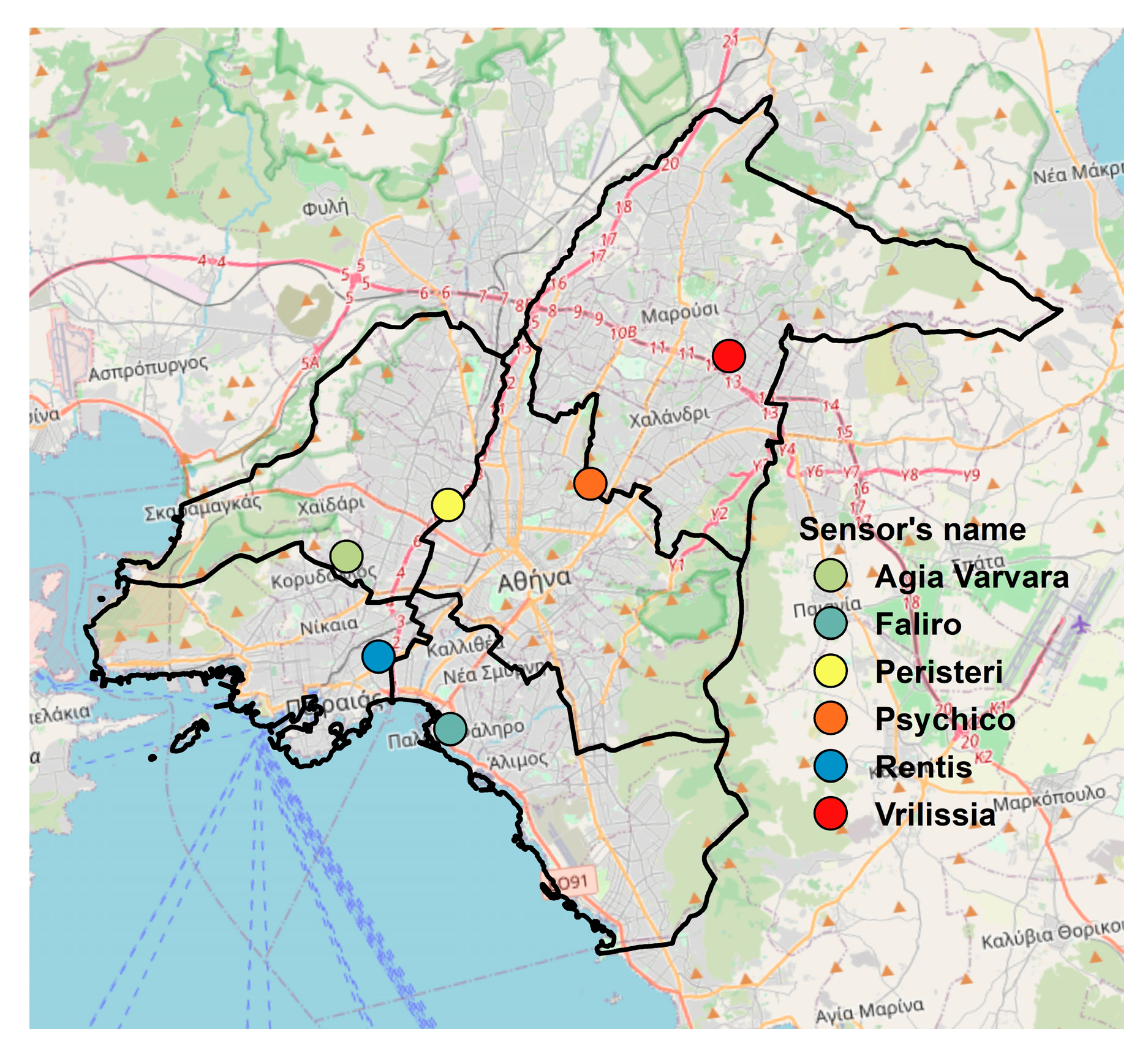Seasonal Changes on PM2.5 Concentrations and Emissions at Urban Hotspots in the Greater Athens Area, Greece †
Abstract
:1. Introduction
2. Materials and Methods
2.1. Instrumentation and Measuring Sites
2.2. FEI-GREGAA Emissions Inventory
3. Results and Discussion
3.1. FEI-GREGAA PM2.5 Emissions
3.2. PM2.5 Measurements
4. Conclusions
Author Contributions
Funding
Institutional Review Board Statement
Informed Consent Statement
Data Availability Statement
Conflicts of Interest
References
- European Environmental Agency. Air Quality in Europe 2022. 2022. Available online: https://www.eea.europa.eu/publications/europes-air-quality-status-2023 (accessed on 30 May 2023).
- EU. Directive 2008/50/EC of the European Parliament and of the Council of 21 May 2008 on Ambient Air Quality and Cleaner Air for Europe. Off. J. Eur. Union 2008. Available online: https://eur-lex.europa.eu/legal-content/en/ALL/?uri=CELEX%3A32008L0050 (accessed on 1 June 2023).
- Ministry of the Environment and Energy. Annual Report on Air Quality. June 2022. Available online: https://ypen.gov.gr/wp-content/uploads/2022/07/%CE%95%CE%9A%CE%98%CE%95%CE%A3%CE%97-2021.pdf (accessed on 1 June 2023). (In Greek)
- Liu, H.; Tian, H.; Zhang, K.; Liu, S.; Cheng, K.; Yin, S.; Liu, Y.; Liu, X.; Wu, Y.; Liu, W.; et al. Seasonal variation, formation mechanisms and potential sources of PM2.5 in two typical cities in the Central Plains Urban Agglomeration, China. Sci. Total Environ. 2019, 657, 657–670. [Google Scholar] [CrossRef] [PubMed]
- Ren, Y.; Wei, J.; Wu, Z.; Ji, Y.; Bi, F.; Gao, R.; Wang, X.; Wang, G.; Li, H. Chemical components and source identification of PM2.5 in non-heating season in Beijing: The influences of biomass burning and dust. Atmos. Res. 2021, 251, 105412. [Google Scholar] [CrossRef]
- Florou, K.; Papanastasiou, D.K.; Pikridas, M.; Kaltsonoudis, C.; Louvaris, E.; Gkatzelis, G.I.; Patoulias, D.; Mihalopoulos, N.; Pandis, S.N. The contribution of wood burning and other pollution sources to wintertime organic aerosol levels in two Greek cities. Atmos. Chem. Phys. 2017, 17, 3145–3163. [Google Scholar] [CrossRef]
- Kosmopoulos, G.; Salamalikis, V.; Matrali, A.; Pandis, S.N.; Kazantzidis, A. Insights about the Sources of PM2.5 in an Urban Area from Measurements of a Low-Cost Sensor Network. Atmosphere 2022, 13, 440. [Google Scholar] [CrossRef]
- Stavroulas, I.; Grivas, G.; Michalopoulos, P.; Liakakou, E.; Bougiatioti, A.; Kalkavouras, P.; Fameli, K.M.; Hatzianastassiou, N.; Mihalopoulos, N.; Gerasopoulos, E. Field evaluation of low-cost PM sensors (Purple Air PA-II) Under variable urban air quality conditions, in Greece. Atmosphere 2020, 11, 926. [Google Scholar] [CrossRef]
- Fameli, K.M.; Assimakopoulos, V.D. The new open Flexible Emission Inventory for Greece and the Greater Athens Area (FEI-GREGAA): Account of pollutant sources and their importance from 2006 to 2012. Atmos. Environ. 2016, 137, 17–37. [Google Scholar] [CrossRef]
- Fameli, K.M.; Papagiannaki, K.; Kotroni, V. Optimizing the knowledge on residential heating characteristics in Greece via crowd-sourcing approach. Atmosphere 2021, 12, 1178. [Google Scholar] [CrossRef]
- Fameli, K.M.; Kladakis, A.; Assimakopoulos, V.D. Inventory of Commercial Cooking Activities and Emissions in a Typical Urban Area in Greece. Atmosphere 2022, 13, 792. [Google Scholar] [CrossRef]




| PM2.5 Emissions (Tonnes/Cell/y) | ||
|---|---|---|
| road transport | residential heating | |
| Faliro | 2.07 | 8.53 |
| Rentis | 2.26 | 15.05 |
| Agia Varvara | 0.92 | 10.01 |
| Peristeri | 4.09 | 10.41 |
| Psychico | 0.67 | 2.45 |
| Vrilissia | 1.37 | 2.02 |
| Statistic | Std. Error | Statistic | Std. Error | ||||
|---|---|---|---|---|---|---|---|
| Faliro | Mean | 16.2139 | 0.15748 | Psychiko | Mean | 14.7333 | 0.0991 |
| Median | 12.32 | Median | 12.4332 | ||||
| Std. Deviation | 14.30867 | Std. Deviation | 9.0042 | ||||
| Min | 3.38 | Min | 3.69 | ||||
| Max | 199.93 | Max | 125.85 | ||||
| Agia Varvara | Mean | 15.6037 | 0.12493 | Vrilissia | Mean | 13.7438 | 0.13575 |
| Median | 12.7309 | Median | 10.549 | ||||
| Std. Deviation | 11.35175 | Std. Deviation | 12.33443 | ||||
| Min | 3.64 | Min | 3.42 | ||||
| Max | 155.36 | Max | 180.87 | ||||
| Rentis | Mean | 16.9271 | 0.16353 | Peristeri | Mean | 17.6635 | 0.17582 |
| Median | 12.8685 | Median | 13.1665 | ||||
| Std. Deviation | 14.85881 | Std. Deviation | 15.97523 | ||||
| Min | 3.63 | Min | 3.64 | ||||
| Max | 193.31 | Max | 230.15 | ||||
Disclaimer/Publisher’s Note: The statements, opinions and data contained in all publications are solely those of the individual author(s) and contributor(s) and not of MDPI and/or the editor(s). MDPI and/or the editor(s) disclaim responsibility for any injury to people or property resulting from any ideas, methods, instructions or products referred to in the content. |
© 2023 by the authors. Licensee MDPI, Basel, Switzerland. This article is an open access article distributed under the terms and conditions of the Creative Commons Attribution (CC BY) license (https://creativecommons.org/licenses/by/4.0/).
Share and Cite
Fameli, K.-M.; Dionysis, K.; Assimakopoulos, V. Seasonal Changes on PM2.5 Concentrations and Emissions at Urban Hotspots in the Greater Athens Area, Greece. Environ. Sci. Proc. 2023, 26, 124. https://doi.org/10.3390/environsciproc2023026124
Fameli K-M, Dionysis K, Assimakopoulos V. Seasonal Changes on PM2.5 Concentrations and Emissions at Urban Hotspots in the Greater Athens Area, Greece. Environmental Sciences Proceedings. 2023; 26(1):124. https://doi.org/10.3390/environsciproc2023026124
Chicago/Turabian StyleFameli, Kyriaki-Maria, Komninos Dionysis, and Vasiliki Assimakopoulos. 2023. "Seasonal Changes on PM2.5 Concentrations and Emissions at Urban Hotspots in the Greater Athens Area, Greece" Environmental Sciences Proceedings 26, no. 1: 124. https://doi.org/10.3390/environsciproc2023026124






